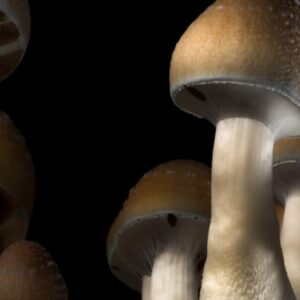Description
Buy Psilocybe cyanofibrillosa Guzmán & Stamets Online
Buy Psilocybe cyanofibrillosa Guzmán & Stamets Onlone. Pileus: 1.4 — 3.5 cm in diameter, conic to convex to broadly convex becoming flat in age, not usually umbonate, deep chestnut brown, hygrophanous fading to yellowish brown or grayish white when dry. Surface viscid when moist from separable gelatinous pellicle.
Gills:
Adnate to adnexed to slightly subdecurrent in age, light grayish becoming purplish brown with age, edges remaining whitish.
Spores:
Purplish brown in deposit. Subellipsoid in shape, (9)9.5 — 11(12) x (5.5)6 — 6.6(7) [[µm]].
Stipe:
3 — 8 cm long x 0.5 cm thick, equal to enlarging near the base, striate, pallid to yellow brown with fine fibrils that stain blue when handled. Partial veil with a cortina, sometimes leaving a fragile annular zone. White rhizomorphs at the base, flesh brownish bruising bluish to indigo-black.
Taste:
Farinaceous.
Odor:
Farinaceous.
Microscopic features: Pleurocystidia absent, basidia 4-spored, rarely 2-spored, cheilocystidia fusiform to lanceolate 22 — 33 × 5.5 — 7 µm, with an elongated, forking neck, 1 — 1.5 µm thick
Diagnostic Description:
It can be distinguished from other closely related species by its smaller spores and forking cheilocystidia. Psilocybe cyanescens also has forking cheilocystidia, but less often than Psilocybe cyanofibrillosa. Psilocybe cyanofibrillosa is also distinguished from Psilocybe cyanescens by an absence of pleurocystidia.
Distribution:
Northern California to British Columbia, Canada, Pacific North West
Habitat:
Scattered to gregarious, September through December, in soils enriched with deciduous wood debris, among bush lupines, in Alder and Willow wood chips and bark mulch, fir sawdust, in coastal regions, in rhododendron gardens and nurseries and also in flood plains in river estuaries.
Look Alikes:
Psilocybe cyanescens
Uses:
Contains psilocybin and psilocin.
Notes:
Also known as “Rhododendron psilocybe” and “Blue-Haired psilocybe”. First documented in 1980 in the Pacific Northwest, it is relatively uncommon. The name of this species refers to the fibrils on the stipe that turn bluish in age, or when handled. Closely related to Psilocybe subfimetaria. Pacific Nortwest Mushroom




Reviews
There are no reviews yet.